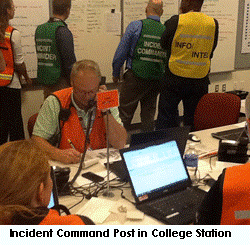Future of emergency response? Joint exercise shows disasters may be managed from a distance
 COLLEGE STATION – When a group of emergency responders at the Center for Domestic Preparedness (CDP) responded to a mock earthquake in Alabama recently, they called in their on-scene reports to an incident command post hundreds of miles away in Texas.
COLLEGE STATION – When a group of emergency responders at the Center for Domestic Preparedness (CDP) responded to a mock earthquake in Alabama recently, they called in their on-scene reports to an incident command post hundreds of miles away in Texas.
This may be the future of incident management, according to the training team running the TEEX portion of the joint exercise. There are few barriers to managing a disaster from a distance as long as there is effective communication, says Training Director Jory Grassinger with the Texas A&M Engineering Extension Service (TEEX).
In this case, the groups in Anniston, AL, and College Station, TX, were linked through a unique computer simulation training tool called the Emergency Management*Exercise System (EM*ES), originally available only at the TEEX Emergency Operations Training Center
. A web-based version of EM*ES launched earlier this year is allowing groups to interact via the Internet to manage a single disaster from multiple locations.
The “Rook Earthquake” scenario served as the capstone exercise for three classes at the CDP and a TEEX class in Enhanced Incident Management/ Unified Command. The CDP classes covered hazard assessment and response management, along with law enforcement response and emergency medical operations for CBRNE (chemical, biological, radiological, nuclear or explosive) incidents.
A June site visit to Anniston by Grassinger and Training Specialist Heather Crites was the first step in the collaboration between the two members of the National Domestic Preparedness Consortium (NDPC). After discussions with CDP officials, the TEEX trainers returned to College Station to develop a scenario that would challenge all of the responders in both locations, and even created a scale map with buildings and streets that corresponded with the Alabama site. To meet the training needs of all of the responders, the earthquake scenario incorporated a rescue and hazmat component, as well as looting and injuries, Grassinger said.
A patient tracking and triage program used in CDP training also was integrated into the scenario. Role players and mannequins that served as “victims” of the mock earthquake were entered into the system and logged according to the extent of their “injuries.” The web-based triage system also tracked which local hospitals received the casualties. The EM*ES computer simulation software and the patient tracking software were available to participants in both locations in real time, Grassinger added.
“This makes the exercise more realistic,” Crites said. “The emergency managers get to talk to responders seeing the incident firsthand, and this also gives the responders interaction with a real management team.”
The collaboration with the CDP is the first time the web-based EM*ES simulation software has connected responders in this fashion, the “boots on the ground” with emergency managers in an incident command post. The training through TEEX’s National Emergency Response and Rescue Training Center and the CDP is offered as part of the DHS/FEMA National Training and Education Division Homeland Security National Training Program. Discussions are underway with other NDPC members on additional collaborative exercises, Grassinger said.
The EM*ES software was designed to support realistic, scenario-based training of multiple disciplines and positions in an incident command post setting. The new web-based version allows for multiple, simultaneous exercises to be performed across several locations anywhere in the world, providing greater flexibility for course delivery and reducing costs.
The Web EM*ES software was developed in conjunction with the Texas A&M Engineering Experiment Station (TEES) and the Texas Center for Applied Technology (TCAT), under the project leadership of TCAT Executive Director Jim Wall.
